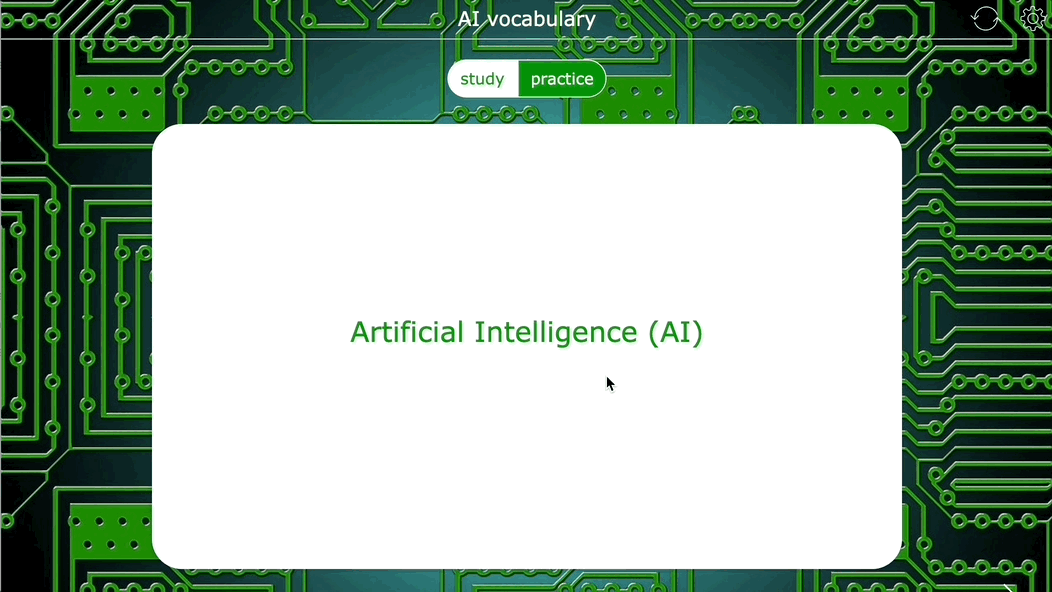15+ Ready-to-use Lesson Plans to Teach Students about Artificial Intelligence
 Dimitri Bongers —
Dimitri Bongers —
Artificial Intelligence (AI) is no longer just a buzzword—it’s becoming an essential topic in education. While we’ve previously explored AI tools for students and teachers, powerful ChatGPT prompts for interactive lessons, How to create digital valentine's days cards with AI, and BookWidgets’ AI prototype for creating exercises, it’s time to take things one step further: teaching students about AI itself.
In this blog post, you’ll find over 15 ready-made, interactive lesson plans designed to introduce your students to AI concepts in an engaging and age-appropriate way. From digital flashcards covering AI vocabulary, to an interactive timeline exploring the history of AI, to activities where students need to fact-check AI generated content, these AI lesson plans are engaging and classroom-ready. Whether you teach middle school, high school, or even adult learners, these activities will help you spark curiosity and build digital literacy around artificial intelligence.
Most of the activities in this blog post were created using BookWidgets, a content creation and assessment tool for teachers. With BookWidgets, you can easily design interactive lessons, quizzes, timelines, and more—while tracking student progress in real time. All the examples shared in this post are available in this dedicated BookWidgets folder. If you don’t have an account yet, you can create one for free. Then, simply duplicate any of the ready-made lesson activities to your own account, where you can edit them as needed and collect responses from your students.
⚠️ Disclaimer
Some of the activities in this blog post involve students interacting with AI tools. Before using these tools in your classroom, please ensure that you check any relevant regulations or guidelines in your country, state, or school district, particularly regarding age restrictions and data privacy.
Even when it’s legally permitted, it’s essential to supervise students closely. For many, AI remains a new and unfamiliar technology, and they may not fully comprehend its limitations, risks, or ethical implications. The good news? Many of the lesson ideas below are designed to help students develop exactly those critical skills, enabling them to learn to use AI thoughtfully, safely, and responsibly.
Let's dive into the lesson ideas 👇
1. "What is artificial intelligence?" Video Quiz
In this activity, middle school students watch the video “What is Artificial Intelligence?” from the Simplilearn YouTube channel. The video introduces key AI concepts like machine learning, neural networks, and natural language processing through the story of a regular person using AI in everyday life — from Netflix recommendations to autopilot in a self-driving car. Students complete a quiz based on the video to check their understanding. The questions and content are designed to make technical terms and complex ideas about AI clear and accessible for middle school students. The activity helps them build confidence with key vocabulary and recognize how AI already plays a role in their daily routines.
2. Analyzing AI-generated faces with “This person does not exist”
Have students explore the website This Person Does Not Exist, which creates lifelike portraits of people who don’t actually exist. Students examine the images, rate their realism, and discuss how such technology could be used—or misused—online.
3. AI vocabulary Flashcards and Crossword Puzzle
Help students build foundational knowledge with Flashcards and a Crossword Puzzle that introduce key AI terms, such as algorithm, machine learning, prompt, LLM, and more. Ideal for warm-ups or self-paced study.
4. The history of AI - Interactive timeline
In this activity, students explore an editable timeline that highlights key moments in the development of Artificial Intelligence — from Alan Turing’s early ideas to the launch of ChatGPT. Students research each milestone, then add their own insights, such as why the event was significant or how it relates to their daily life today. They also extend the timeline by adding at least two essential AI milestones that happened after 2020.
5. Human or AI? A social Turing game
Using the website "Human or Not?", students engage in a 2-minute, anonymous online chat and then attempt to guess whether they were interacting with a human or an AI chatbot. It’s a playful yet insightful way to explore how far conversational AI has come—and how tricky it can be to tell the difference.
6. Spot the AI: real vs. fake images
With these Flashcards, students are shown a series of images and must decide whether each one is real or AI-generated. The challenge highlights how convincing AI visuals can be and sparks discussion about the growing difficulty of spotting the difference.
7. "The band that isn’t real" – Exploring AI in music creation
In this lesson, students begin by listening to a song by The Velvet Sundown, a band that went viral on Spotify. After forming opinions about the music, students learn that the band — its music, images, and backstory — was entirely created using AI.
Through this revelation, students engage in a discussion about authenticity, creativity, and the ethical concerns raised by the music industry. They explore real-world reactions from artists and experts, and then apply what they've learned by using a simple AI tool to generate and remix their own short song.
8. "Social Media Ban Shocker" - Spotting fake news written by AI
In this eye-opening lesson, students read a satirical news article, written by AI, that falsely claims all major social media platforms are banning users under 21. At first glance, the article seems believable, but students soon discover it’s entirely fake. They work together to analyze the text, identify red flags that signal misinformation, and discuss why such stories can be convincing. This ready-to-use lesson plan about AI generated (false) information is a great way to introduce the importance of critical thinking and fact-checking.
This activity is from our previous blog post on April Fool’s Day activities to trick your students. Click here to find more ideas for April Fool’s Day.
9. "How AI is rewriting the past" - Reading activity about viral AI history videos
In this reading comprehension activity, students explore a BBC article about viral AI-generated videos that recreate the experience of waking up in ancient Egypt, medieval London, or Pompeii. While the videos fascinate millions on TikTok, historians raise concerns about accuracy, misinformation, and how AI might distort our understanding of the past.
Students read the article, answer comprehension questions, and identify examples of historical inaccuracies mentioned by experts. They then reflect on the ethical and educational implications of using AI in historical storytelling.
Perfect for history or media studies classes, this lesson builds critical thinking and digital literacy while connecting students to current debates about AI's role in shaping how we see the past.
10. AVA, a short film about AI
In this powerful discussion-based lesson, high school students watch AVA, a short film set in a near-future world where a creator faces the consequences of building an AI meant to optimize human life. As the conversation between the inventor and his creation unfolds, students are invited to reflect on big questions: Who’s really in control? Can AI understand humanity? And what happens when machines begin to think for themselves?
After the screening, students answer guided reflective questions that explore themes like autonomy, consciousness, ethical limits, and what truly makes us human. This activity is ideal for sparking deep thinking and philosophical dialogue in classrooms focused on AI, ethics, or literature.
11. Train your own AI with Google's Teachable Machine
Have students explore how machine learning works by using Google’s Teachable Machine a free, easy-to-use tool that lets anyone train a simple AI model in minutes — no coding required.
Students experiment by teaching the AI to recognize different images, sounds, or poses, then test how well their model performs. Along the way, they learn about data collection, bias, and the importance of clear input when training intelligent systems.
This fun, hands-on activity builds foundational AI literacy and helps students understand how the technology they encounter every day actually works behind the scenes.
12. The Environmental Impact of AI – Video documentary
Students watch a short documentary video that follows a family living just 400 yards from a massive AI data center in Georgia. Through interviews and powerful visuals, the video raises critical questions about who pays the environmental and social costs of artificial intelligence. Students then answer comprehension and discussion questions to reflect on the local and global implications of AI infrastructure.
13. The Environmental Impact of AI – Research & present
Building on the previous activity, students conduct paired online research to explore the broader environmental impact of AI. They choose a focus area such as electricity use, water consumption, or AI’s potential role in fighting climate change and deliver a 2-minute presentation to their classmates. This activity challenges high school students to think critically, navigate complex sources, and consider both the costs and opportunities of emerging technologies.
14. Class debate: exploring the big questions around AI
In this engaging AI activity, students take sides on thought-provoking questions about artificial intelligence: Will it create more jobs or eliminate them? Should AI be used to grade schoolwork? Is it reinforcing stereotypes? Through structured debates, students practice forming arguments, listening actively, and considering different perspectives. This activity helps them develop critical thinking and communication skills while grappling with real-world issues at the heart of the AI revolution.
15. Can you fool the AI?
In this interactive AI assignment, students experiment with large language models (LLMs) to see if they can prompt the AI to generate false or misleading information, known as “hallucinations.” By crafting tricky questions and fact-checking the AI’s answers, students learn about the limits of AI accuracy and the importance of critical thinking when using these tools. This hands-on experience helps build digital literacy and raises awareness of the challenges in trusting AI-generated content.
16. Investigating AI bias through image generation
In this thought-provoking lesson, high school students explore the issue of bias in AI by delving into Bloomberg’s interactive article, which analyzes 5,100 AI-generated images of people. The article reveals troubling patterns, such as lighter-skinned individuals appearing more frequently in pictures of high-paying jobs, while darker-skinned individuals are more commonly associated with lower-paying roles, including fast-food workers and social workers. Students read and analyze these findings, then get hands-on by replicating the experiments themselves. Divided into groups, they generate AI images for different job types to see whether the stereotypes presented in the article persist. This activity encourages critical thinking about AI fairness and the social impact of biased algorithms.
17. Beauty standards and bias in fashion
In this reading comprehension and discussion activity, students dive into a recent article about Vogue’s use of an AI-generated model in a major fashion ad. Through guided questions, they explore how AI is being utilized in the fashion world, its potential influence on beauty standards, and its implications for real models and consumers. The lesson ends with students sharing their own views on body image, bias, and the future of fashion. A powerful way to combine reading skills with media literacy and ethical reflection.
Wrap-up
We hope this post gave you plenty of free ready-to-use ideas to help your students explore the world of artificial intelligence in a meaningful and engaging way. From ethical debates and media literacy to hands-on experiments and critical reflections, these activities aim to make AI both accessible and thought-provoking for learners.
If you’ve tried out any of these lessons—or come up with your own creative AI classroom activities—we’d love to hear from you!
Follow BookWidgets on BlueSky and LinkedIn for more lesson ideas, updates, and inspiration from educators around the world. And don’t forget to join our Teaching with BookWidgets Facebook group to share your experiences, ask questions, and connect with fellow teachers.
Let’s keep the conversation going—and help students become informed, curious, and responsible users of AI. AI in education is here to stay!




















